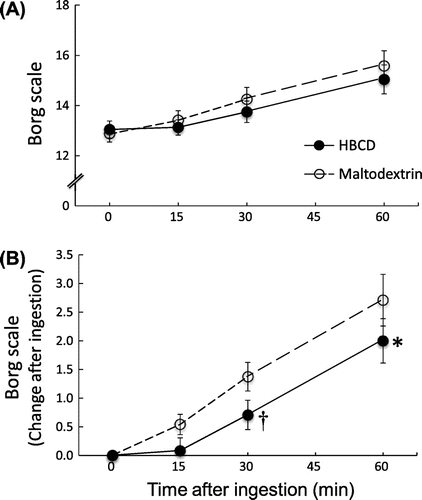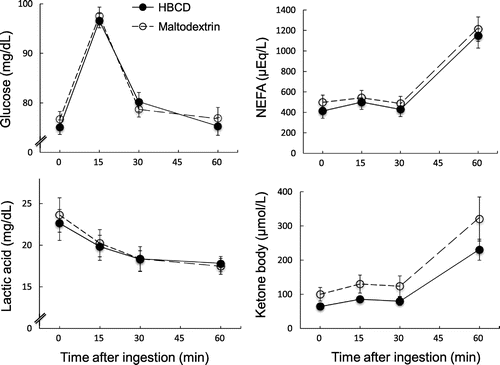Abstract
We compared the effect of relatively low doses (15 g) of highly branched cyclic dextrin (HBCD) with that of maltodextrin during endurance exercise on the rating of perceived exertion (RPE) in a crossover, double-blind study of healthy volunteers. The RPE increased during exercise and its increase was significantly less at 30 and 60 min after ingesting HBCD than maltodextrin.
Novel, highly branched cyclic dextrin (HBCD) produced from waxy corn starch using a branching enzyme has an average molecular weight of 400,000 with a narrow size distribution.Citation1) Sports drinks include HBCD as a carbohydrate component because it has high solubility, low viscosity, and is tolerant to retrogradation.Citation1) Gastric emptying time is shorter for drinks containing HBCD compared with glucose and standard dextrin due to having a much lower osmotic pressureCitation2) and this also results in less gastrointestinal disorders developing in humans during exercise.Citation3) In addition, administering 0.5 g/kg body weight (BW) of HBCD to miceCitation4) and 1.5 g/kg BW to humans reportedly increases exercise endurance.Citation1) However, the concentration of carbohydrate in sports drinks is relatively low (<10%) to promote gastric emptying,Citation2,5) and thus, only a limited amount of carbohydrate is consumed during exercise. The present study compares the effects of a relatively low dose (15 g) of HBCD with those of maltodextrin during endurance exercise on the rating of perceived exertion (RPE) and blood components associated with energy metabolism.
Soiken Inc. (Osaka, Japan) recruited 24 healthy male volunteers aged between 25 and 39 (average, 34.8 ± 4.0) years and a body mass index of 23.7 ± 2.7 (mean ± S.E.). The exclusion criteria comprised food allergies, blood donation (≥200 or ≥400 mL within 1 or 3 months, respectively), or previously diagnosed with cardiovascular, endocrine, metabolic, respiratory, liver, or renal disorders requiring treatment. The Ethics Committee of Fukuda Internal Medicine Clinic approved the study protocol. Physicians provided the volunteers with a description of the study and all of them provided written informed consent to participate in compliance with the Declaration of Helsinki.
Two test drinks were prepared by dissolving 15 g of HBCD (Ezaki Glico Co. Osaka, Japan) or maltodextrin (average molecular weight of 23,600, Glucidex 19D; Roquette Frères, Lestrem, France) in 200-mL distilled water. The sweetness of the drinks was adjusted with sucralose, and we confirmed that they were indistinguishable for taste.
All participants in this double-blind, randomized, crossover consumed one test drink, then the other 2 weeks later. We randomly assigned the participants to two groups. The O2max was measured at least 2 weeks before the first experiment. The average
O2max for 24 subjects was 37.0 ± 1.2 mL/kg BW/min. All participants refrained from vigorous physical exercise on the day before and during the experiments and maintained their regular dietary habits. The participants consumed the same meal on the day before the experiment by 21:00, and ingested only water thereafter. After an overnight fast, the participants reported to the clinical laboratory at around 09:00 am They consumed plain bread (2 kcal/kg BW) to avoid becoming hypoglycemic during the exercise, rested for 60 min, and then started exercise using an Aerobike 75XL-II bicycle ergometer (Konami Sports & Life Co. Tokyo, Japan) at 40%
O2max for 30 min and then at 60%
O2max for 90 min (total 2 h of exercise). The participants consumed one of the drinks at 1 h after starting exercise. The RPE was measured and blood was collected from the brachial vein immediately before and at 15, 30, and 60 min after ingesting a test drink. We then determined values for plasma glucose, lactic acid, and ketone bodies (3-hydroxybutyric acid + acetoacetate), as well as serum non-esterified fatty acids (NEFA) and insulin using conventional clinical methods: plasma glucose and insulin by BML Inc. (Tokyo, Japan) and lactic acid, ketone bodies, and NEFA by Oriental Yeast Co. Ltd, (Tokyo, Japan). Data were statistically analyzed using Stat Mate III 3.14 software (ATMS Co. Ltd, Tokyo, Japan). Differences in RPE between trials of the two test drinks were assessed using a two-tailed Wilcoxon signed-rank test and differences in blood components were analyzed using a two-tailed paired Student’s t-test. Values with p < 0.05 were accepted as indicating statistically significant differences.
The values of RPE measured during exercise (before and 15, 30, and 60 min after ingestion) were not significantly different between HBCD and maltodextrin ingestion but tended to be lower after consuming HBCD than maltodextrin (Fig. (A)). Therefore, we calculated changes in RPE after ingestion of the test drinks, and the results showed that the increase in RPE at 30 and 60 min after ingestion was significantly lower after consuming HBCD than maltodextrin (Fig. (B)). Both drinks increased blood glucose concentrations, which showed a peak at 15 min after ingesting both drinks, and the blood glucose concentrations at time measured point were not significantly different between two drinks (Fig. ). We further calculated the increase in the blood glucose concentration after ingestion of the drinks, and the level of the increase at 15 and 60 min after ingestion was same between two drinks, but that at 30 min after ingestion tended to be higher in ingesting HBCD than maltodextrin (5.1 ± 2.1 vs. 2.0 ± 1.8 mg/dL, p < 0.1). Fig. shows that concentrations of blood lactic acid, non-esterified fatty acids (NEFA), and ketone bodies after ingesting both drinks did not differ at any time measured point and neither did changes in blood insulin concentrations (data not shown). The mechanism responsible for suppressing RPE elevation during exercise after ingesting HBCD was not clear, but it might be associated with the ability of HBCD to supply glucose energy for a longer period and its shorter gastric emptying time.Citation1,2,4) Further study is required to clarify the detailed mechanism responsible for lower RPE after ingesting HBCD than maltodextrin during exercise.
Notes
Abbreviations: HBCD, highly branched cyclic dextrin; NEFA, non-esterified fatty acid; RPE, rating of perceived exertion.
References
- Kometani T, Takii H, Shiraki T, Nomura T. Endurance enhancing effect of cyclic cluster dextrin. FOOD Style21. 2003;7:62–65.
- Takii H, Takii-Nagao Y, Kometani T, Nishimura T, Nakae T, Kuriki T, Fushiki T. Fluids containing a highly branched cyclic dextrin influence the gastric emptying rate. Int. J. Sports Med. 2005;26:314–319.
- Takii H, Kometani T, Nishimura T, Kuriki T, Fushiki T. A sports drink based on highly branched cyclic dextrin generates few gastrointestinal disorders in untrained men during bicycle exercise. Food Sci. Technol. Res. 2004;10:428–431.10.3136/fstr.10.428
- Takii H, Ishihara K, Kometani T, Okada S, Fushiki T. Enhancement of swimming endurance in mice by highly branched cyclic dextrin. Biosci. Biotechnol. Biochem. 1999;63:2045–2052.10.1271/bbb.63.2045
- Gisolfi CV, Duchman SM. Guidelines for optimal replacement beverages for different athletic events. Med. Sci. Sports Exercise. 1992;24:679–687.


